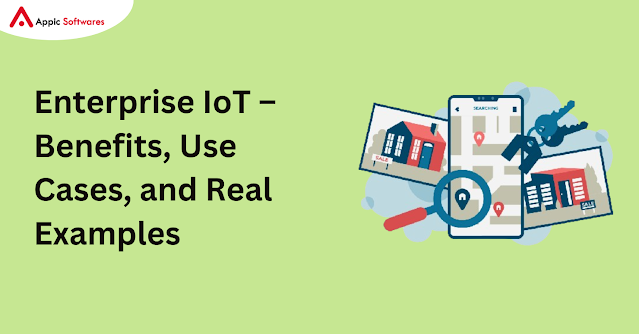Enterprise IoT – Benefits, Use Cases, and Real Examples
In today's interconnected world, the Internet of Things (IoT) has emerged as a transformative force, revolutionizing industries and businesses across the globe. Within the realm of enterprise, IoT holds immense potential to streamline operations, enhance efficiency, and drive innovation. From manufacturing plants to healthcare facilities, IoT is reshaping the way businesses operate, offering a myriad of benefits and opportunities. In this comprehensive guide, we'll delve into the benefits, explore various use cases, and examine real-world examples of how enterprises are leveraging IoT to gain a competitive edge.
Benefits of Enterprise IoT:
Enhanced Operational Efficiency:
- IoT enables real-time monitoring and data collection from various devices and sensors, allowing enterprises to optimize processes and reduce downtime.
- Predictive maintenance powered by IoT analytics helps in identifying potential equipment failures before they occur, thereby minimizing disruptions and maximizing uptime.
- Automation of routine tasks through IoT integration frees up human resources to focus on more strategic activities, leading to increased productivity.
Cost Savings:
- By optimizing resource utilization and reducing energy consumption, IoT helps in lowering operational costs for enterprises.
- Predictive analytics and data-driven insights enable better inventory management, reducing wastage and inventory holding costs.
- Remote monitoring and management capabilities offered by IoT solutions minimize the need for on-site personnel, resulting in reduced labor costs.
Improved Decision Making:
- IoT generates a wealth of real-time data that can be analyzed to gain valuable insights into business operations.
- Advanced analytics and machine learning algorithms process this data to provide actionable intelligence, enabling informed decision-making.
- Real-time monitoring of key performance indicators (KPIs) empowers executives to identify trends, spot anomalies, and make timely adjustments to business strategies.
Enhanced Customer Experience:
- IoT enables enterprises to offer personalized and immersive experiences to their customers through connected products and services.
- Real-time tracking and monitoring capabilities enhance visibility into supply chains, enabling enterprises to provide accurate delivery timelines and improve customer satisfaction.
- IoT-powered devices can collect valuable feedback and usage data, enabling enterprises to refine their offerings based on customer preferences and behavior.
Safety and Security:
- IoT enhances workplace safety by enabling proactive monitoring of environmental conditions and equipment performance.
- Surveillance cameras, access control systems, and biometric sensors powered by IoT technologies bolster physical security measures within enterprises.
- Advanced encryption protocols and security frameworks ensure the confidentiality and integrity of data transmitted across IoT networks, mitigating cyber threats.
Use Cases of Enterprise IoT:
Smart Manufacturing:
- Predictive maintenance: IoT sensors monitor equipment health and performance in real-time, enabling proactive maintenance to prevent costly breakdowns.
- Asset tracking: RFID tags and GPS sensors track the movement of raw materials, work-in-progress, and finished goods throughout the manufacturing process, optimizing supply chain logistics.
- Quality control: IoT-enabled cameras and sensors detect defects on the production line, ensuring product quality and reducing rework.
Healthcare and Remote Monitoring:
- Remote patient monitoring: Wearable devices equipped with IoT sensors track vital signs and health metrics, enabling healthcare providers to monitor patients remotely and intervene proactively.
- Asset management: IoT solutions track the location and usage of medical equipment within healthcare facilities, ensuring optimal utilization and maintenance.
- Medication adherence: Smart pill bottles equipped with IoT sensors remind patients to take their medication on time and provide feedback to healthcare providers on adherence levels.
Smart Cities and Urban Infrastructure:
- Traffic management: IoT sensors embedded in roads and traffic lights monitor traffic flow in real-time, optimizing signal timings and reducing congestion.
- Waste management: Smart bins equipped with fill-level sensors alert waste management authorities when they need to be emptied, optimizing collection routes and reducing operational costs.
- Environmental monitoring: IoT devices measure air quality, noise levels, and pollution levels in urban areas, providing valuable data for urban planning and policy-making.
Retail and Customer Engagement:
- Inventory management: RFID tags and IoT sensors track inventory levels in real-time, enabling retailers to optimize stock levels and prevent stockouts.
- Personalized marketing: IoT-powered beacons and sensors in stores collect data on customer preferences and behavior, enabling retailers to deliver targeted promotions and enhance the shopping experience.
- Smart checkout: IoT-enabled checkout counters automate the payment process and provide a seamless shopping experience for customers, reducing waiting times and improving operational efficiency.
Real-world Examples of Enterprise IoT:
Siemens: The industrial giant leverages IoT technology in its "Digital Twin" concept, where virtual replicas of physical assets are created to monitor, analyze, and optimize performance in real-time. This approach enables predictive maintenance, reduces downtime, and enhances operational efficiency across various industries.
Amazon Go: The cashier-less grocery stores from Amazon utilize a network of cameras and sensors to track customer movements and purchases, enabling frictionless shopping experiences. IoT technology powers inventory management, real-time analytics, and seamless checkout processes.
Rolls-Royce: The aerospace manufacturer employs IoT sensors in its jet engines to collect vast amounts of operational data during flights. This data is analyzed to optimize engine performance, improve fuel efficiency, and predict maintenance needs, ultimately reducing operating costs for airlines.
Coca-Cola: The beverage giant utilizes IoT technology in its vending machines to remotely monitor inventory levels, track sales data, and optimize restocking schedules. This enables Coca-Cola to ensure product availability, minimize downtime, and enhance customer satisfaction.
.png)


.jpg)
Comments
Post a Comment